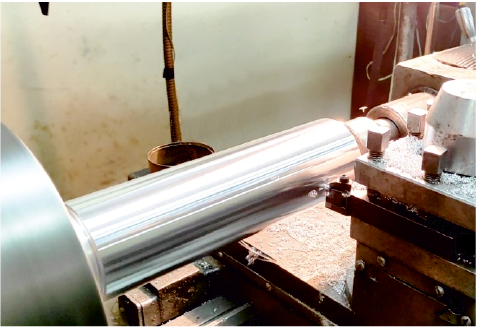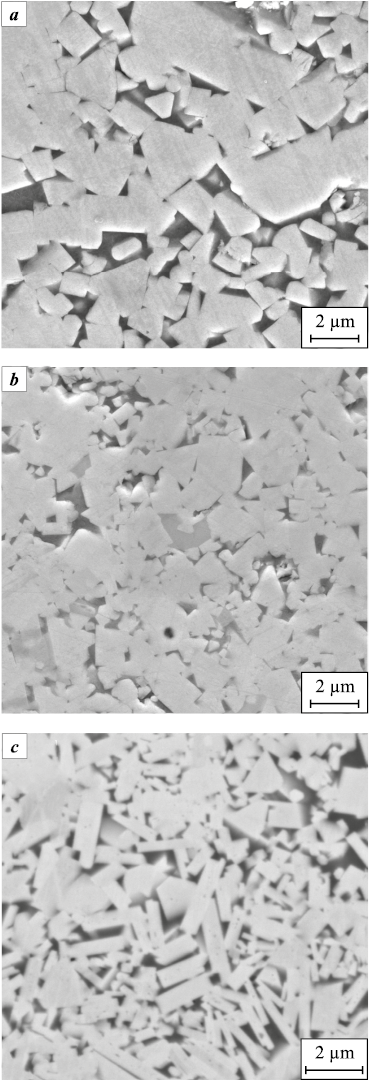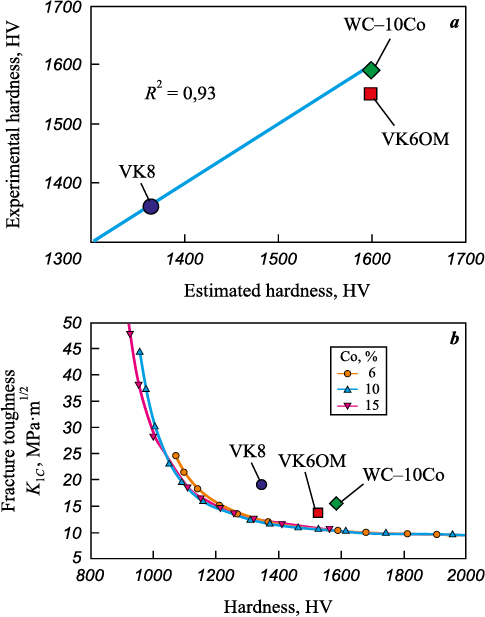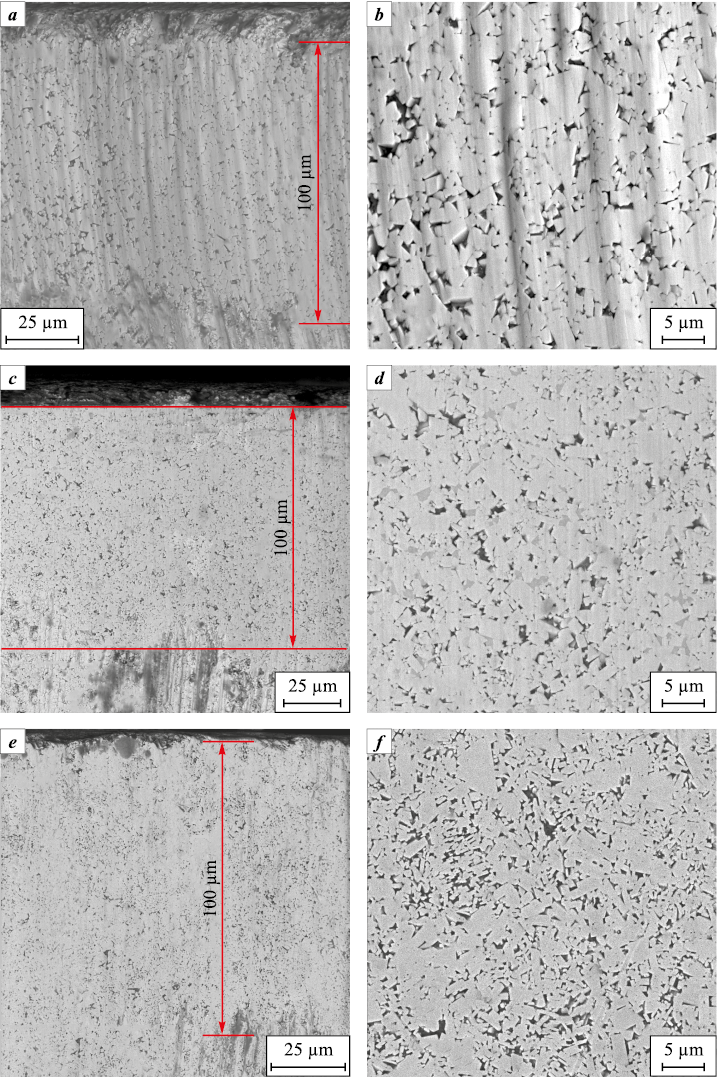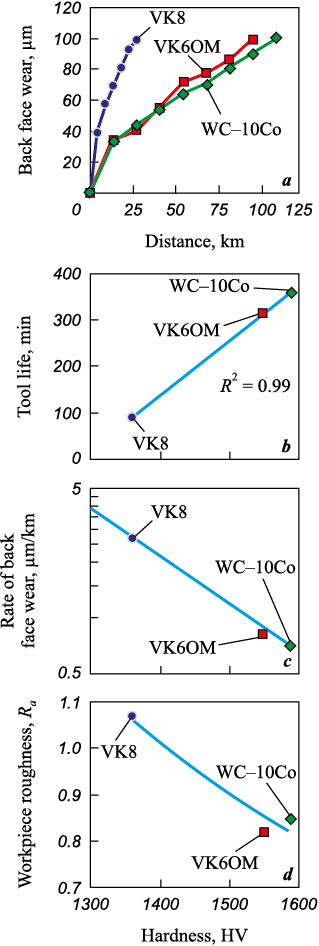Scroll to:
Comparative analysis of the tool life of submicron hard alloy WC-10Co sintered from powder obtained by electro discharge in oil
https://doi.org/10.17073/1997-308X-2023-1-75-84
Abstract
In this paper, comparative studies of the microstructure, mechanical characteristics and service life of a cutting insert made of submicron cemented carbide WC-10Co, obtained as a result of recycling VK10 cemented carbide by Electro Discharge Erosion (EDE) in oil, were carried out. The specific energy consumption directly for the formation of pulses in the process of EDE is to a relatively small value (5.7 kW·h/kg). Excess carbon formed as a result of oil pyrolysis during EDE was removed by heat treatment. The granulometric composition of the obtained powder and the microstructure of the particles were studied. It is shown that the particles of the resulting powder consist of plate-like WC grains with an average diameter of 0.46 pm and interlayers of cobalt. The WC-10Co cutting insert, obtained by sintering this powder in vacuum, was used for a comparative analysis of service life during fine turning of aluminum alloy D16T. As objects for comparative analysis, cutters equipped with blades made of industrial alloys VK8 and VK6OM of a similar design were used. The microstructure and mechanical characteristics of the experimental alloy and the analogues presented have been studied. On the basis of studies of the microstructure and chemical composition of the back surface of the cutting inserts, the wear mechanism of the cutters was analyzed. It is shown that the hardness of the alloys has the main effect on their wear resistance when cutting an aluminum alloy with the presented cutters. The influence of the hardness of the cutters on the surface roughness of the resulting part was also studied. The obtained submicron cemented carbide WC-10Co exhibits the highest hardness (1590 HV) and wear resistance of the presented samples due to the smallest WC grain diameter (0.59 pm).
For citations:
Dvornik M.I., Vlasova N.M. Comparative analysis of the tool life of submicron hard alloy WC-10Co sintered from powder obtained by electro discharge in oil. Powder Metallurgy аnd Functional Coatings (Izvestiya Vuzov. Poroshkovaya Metallurgiya i Funktsional'nye Pokrytiya). 2023;17(1):75-84. https://doi.org/10.17073/1997-308X-2023-1-75-84
Introduction
Due to the combination of high indices of strength, hardness and wear resistance, tungsten-cobalt (WC–Co) cemented carbides are extensively used in industry [1–3]. Obtaining submicron and ultrafine grained cemented carbides of high hardness and wear resistance as well as reducing the costs of their production represent an urgent task nowadays [4; 5]. High cost of cemented carbides associated with the limited reserves of cobalt and tungsten. In the view of this, all cemented carbide wastes are recycled and used for the production of new articles. Owning to high hardness, strength and chemical stability, the cemented carbides are to be processed by costly chemical methods using hazardous and environmentally destructive chemicals [6–9]. One of the promising alternative methods for obtaining powders directly from pieces of material without using of hazardous reagents is Electro Discharge Erosion (EDE) [10–16].
The EDE method is based on the erosion of electrodes and the formation of particles during a spark discharge passing in a dielectric liquid. Under the impact of a spark discharge, the surface of the electrodes is heated up to ~104 K [17; 18] that results in the melting and boiling of the initial material inside a vapor bubble formed upon the boiling of dielectric liquid. After the spark discharge passes, the vapor bubble collapses, the molten and boiling material is ejected into the interelectrode gap and cooled at a rate of 106–109 K/s. Cooling results in the formation of ultrafine-grained particles of predominantly spherical shape.
Researchers have already developed a technology for processing the alloy, including the production of powders by EDE method, thermochemical treatment and vacuum sintering [14; 15]. Due to a small grain size, the obtained samples of cemented carbides are not inferior to their analogues, obtained by other methods, in terms of the combination of hardness and fracture toughness. However, no works on the research of the service life of the cutting tools equipped with these carbides have been found in the available literature, which makes it difficult to identify the prospects for their application. This problem applies to all ultrafine-grained and submicron carbides whose production has commenced in recent decades.
To answer the question about the prospects of using submicron cemented carbides produced by sintering the powders obtained by EDE and other methods, it is required to research their service life in comparison with their analogues during the mechanical processing of the material in the conditions corresponding to these carbides. The closest analogues of submicron cemented carbides are medium-grained and extra fine-grained cemented carbides produced by modern industry and applied for the treatment of non-ferrous alloys.
The paper was aimed at the research of wear resistance of submicron cemented carbide, produced by sintering of the powder, obtained by recycling by EDE method, and its analogues during the cutting of aluminum alloy.
Methods
The powder for the initial carbide was obtained by electro discharge erosion of VK10 (90 % WC + 10 % Co) medium-grained carbide. The refined carbide inserts with the dimensions of 10–20 mm and a total initial weight of 50 g were subjected to electro discharge erosion for 60 min on a specially designed plant [14; 15]. The pulse generator parameters are as follows: average pulse energy – 5 J, pulse frequency – 35 Hz, pulse voltage – 250 V, used liquid – dielectric oil (GK-1), EDE duration – 1 h. The energy expended directly for the passage of power pulses was calculated based on the current-voltage characteristics, which were measured by means of analogue-to-digital converter connected to the anode and cathode through a voltage divider.
After EDE, the powder was collected as a deposit. The obtained paste was placed in a ceramic crucible and subjected to vacuum drying at a temperature t = 500 °С in “Carbolite STF” vacuum furnace. Afterwards, the powder was ground for 5 min by means of “Retsch PM 400” grinder, weighed, analyzed for carbon content using “Emia 320V2” analyzer, and excess carbon was removed by heating the powder at t = 1000 °C for 20 min in CO2 environment. The granulometric analysis was performed by means of “Analysette 22 Microtec” analyzer. The microstructure of the particles was studied after they were mixed with epoxy resin and polished. A batch of the obtained powder was mixed with a binder (benzine-based adhesive), then dried (the concentration of the binder was 1 wt. %), granulated, and 3 blanks were pressed from it. The blanks were sintered at t = 1410 °С in a vacuum furnace for 1 h.
Standard straight-turning side cutters equipped with brazed inserts made of VK8 and VK6OM hard alloys were used as analogues for the analysis of wear resistance. A cutting insert of experimental WC–10Co alloy with the same shape of cutting edge was made and fixed mechanically (Fig. 1, a). The main parameters of the used cutters were the same: primary back clearance angle – 10°, primary front clearance angle – 0°, primary entering angle – 80°, root radius – 0,5 mm (Fig. 1, b–d).
Fig. 1. Cutters studied for wear resistance (a) and the top view of cutting |
The microstructure of the samples was studied after grinding and polishing of the surface. The average WC grain diameter was calculated according to the standard method (ASTM E112-13:2021), namely by intercept method. Vickers hardness of all alloys was measured by means of HVS-50 hardness meter (error 2 %) under load P = 294 Н (30 kgf). Fracture toughness (K1C ) calculated according to the total length of the cracks \(\left( {\sum l } \right)\) under Palmqvist scheme (ISO 28079) using Shetty equation:
\[{K_{1C}} = 0.028\sqrt {HV\frac{P}{{\sum l }}} .\]
The service life of the cutters was studied by fine turning of aluminum alloy D16T, which is one of the most demanded structural materials for the manufacture of parts in the aerospace and shipbuilding industry. The turning of the blank (Fig. 2) was performed on 16K20 turner under the same conditions until the wear of back face of 100 µm was reached. The maximum possible cutting speed V = 300 ± 20 m/min, ensured by this turner, was chosen. The depth of cut was 0.5 mm, the feed was 0.07 mm/rev. Back surface wear was measured by means of “Altami” optical microscope every 15 min (4.5 km) for VK8 alloy and every 45 min (13.5 km) for VK6OM and WC–10Co alloys. The microstructure of the back surface of the cutting inserts was studied using “Tescan Vega” scanning microscope. The surface of the cutting inserts was previously cleaned with alkali to remove build-up and adhered chips. The content of oxygen and metals in the back surface of the cutter was studied using “Oxford X-Max 80 SDD-EDXS” energy dispersive X-ray fluorescence detector.
Fig. 2. The machined blank and the cutter during turning |
Results and Discussion
As a result of recycling VK10 cemented carbide by Electro Discharge Erosion (EDE) in oil, spherical microparticles and agglomerates of nanodispersed particles mixed with free carbon, formed as a result of pyrolysis of hydrocarbons, were obtained. The process rate was 32 g/h, the specific energy consumption for the passage of current pulses through the unit made up 5.7 kW·h per 1 kg of powder. If required, the process rate can be increased many times by increasing the power of the pulse generator [16].
The phase composition of the obtained powder after drying at a temperature of 600 °С does not differ from the original carbide (WC + Co). The total carbon content in the powder increased to 8.1 % due to the formation of free carbon during the oil pyrolysis. Using the proven methodology [14], excess carbon (2.6 %) was totally removed by means of powder annealing at t = 1000 °С in vacuum furnace, filled with the equivalent CO2 content. The powder obtained after the removal of free carbon, consisted of WC–Co particles (Fig. 3, a), the average diameter of which was 11.2 µm (Fig. 3, b). The spherical particles were plate-like WC grains with an average diameter of 0.46 μm (Fig. 3, c), the space between which was filled with cobalt.
Fig. 3. Powder morphology (a), its granulometric composition (b) |
When sintering WC–10Co carbide, the average diameter of WC grains increased up to 0.59 μm (Fig. 4, a). After sintering, WC–10Co cutting insert was produced, then it was mechanically fastened on the holder and turned. The reduced rigidity of the insert with mechanical fastening does not cause deformations that impact the wear of the cutters, since cutting forces do not reach significant values with the selected cutting mode (fine turning). Due to the low hardness of the alloy being processed and the small depth of cut (finishing), the resulting forces could not cause cracking of the brazed inserts and displacement of the insert with mechanical fastening. The characteristics of alloy materials, which primarily depend on their composition and microstructure, exert a major influence on the wear resistance of the cutter.
Fig. 4. The microstructures of hard alloys |
The hard alloys used are distinguished from each other by their cobalt content, the presence of TaC in VK6OM alloy, as well as grain shape and size. Since the selected alloys differ slightly in their chemical composition, the mechanical characteristics of the alloys, which depend on the grain diameter and cobalt content, have a major influence on the wear rate. The microstructure of the alloys (Fig. 4) clearly shows that VK8 alloy exhibits the largest grain diameter and the experimental WC–10Co alloy – the smallest.
Using data on the average grain diameter, mass fraction of cobalt (see the Table) and the simple ratios for calculating the volume fraction of cobalt and adjacency, the theoretical hardness values for the presented hard alloys were calculated based on the Gerland and Lee model [19; 20]. The obtained results are in satisfactory agreements with the experimental values (Fig. 5, a). Medium-grained VK8 alloy exhibits the lowest hardness. WC–10Co and VK6OM submicron alloys have approximately equal values HV. The high hardness of WC–10Co alloy is provided by a smaller average grain diameter, despite the higher cobalt content compared to VK6OM alloy. VK8 alloy is characterized by the highest fracture toughness among the presented alloys, VK6OM alloy is characterized by the lowest fracture toughness due to the low cobalt content. The fracture toughness of experimental WC–10Co alloy turned out to be slightly higher than that of VK6OM alloy (Fig. 5, b) due to the higher cobalt content and the presence of plate-like WC grains, which improve the overall characteristics of the alloy [14; 21]. The conducted tests were selected in accordance with the application of VK6OM and VK8 alloys used, among other things, for turning aluminum alloys.
Main characteristics of alloys
Fig. 5. The comparison of experimental values (symbols) |
The Mechanism of Wear
According to modern researches [22], when turning an aluminum alloy, the adhesive, diffusion and abrasive wear of carbide cutting inserts is observed. The temperature of the cutter tip under close turning conditions (cutting speed of 360 m/min) is 315 °C [22]. Increased temperature and high contact pressure on the tip of the cutter on the side of the machined workpiece result in mechanical sticking or fusing of the machined aluminum alloy on the back surface of the cutter. The diffusion wear is insignificant in such conditions, since the solubility of cobalt in aluminum is low at this temperature [24]. An adhesive layer is formed under the build-up surface, it contains the compounds of cobalt, tungsten, aluminum and their oxides, which are removed during cutting. The formed build-up is involved in cutting and is periodically cut off. When it is cut, the wear of the edge and the back surface of the cutter occurs.
Upon cutting, the cobalt layers are removed first because of their lower hardness and greater chemical reactivity. The energy-dispersive analysis of the studied sections confirmed that there was a decrease in the concentration of cobalt on the back surface of the cutter by a constant value of 25 % of its initial content (Fig. 6). Since the decrease in the fraction of cobalt indicates the depth of its location, it can be concluded that it is removed to a certain depth, regardless of the size of WC grains. The removal of cobalt results in the formation of microroughnesses from protruding carbide grains, which are clearly visible at high magnification (Fig. 7, b, d, f ). The results of energy-dispersive analysis also indicate that the components of the aluminum alloy do not penetrate into the surface layers of the hard alloy (Fig. 6). The oxygen content in the surface layers of wear (1.5–2.0 %) exceeds its concentration in the surface of alloy (1.1 %), which may indicate oxygen diffusion and oxide layer formation.
Fig. 6. The results of energy dispersive analysis | ||||||||||||||||||||||
Fig. 7. The photos of the worn back surface of VK8 (а, b), |
The wear surface of VK8 alloy (Fig. 7, a, b) shows shallow, smooth grooves with slip bands in them, formed by shearing off the adhesive layer. In the VK6OM and WC–10Co alloys, no grooves are detected even at the highest magnification (Fig. 7, d, f ). Namely, the removal of components of harder alloys (VK6OM and WC–10Co) occurs only in a layer less than 1 µm thick. The wear of the edge of VK8 hard alloy can also be noticed (Fig. 7, a). The wear of the edge of VK6OM and WC–10Co alloys is insignificant, since their hardness is higher.
The kinetic dependence of increase of wear value along the back face on the covered distance consists of cutting-in and linear wear sections (Fig. 8, a). The wear of the studied alloys at the initial stage differs insignificantly (~0.03 mm). Deviations from a straight line in a linear section are also insignificant. An increase in hardness results in an increase in service life of hard alloys (Fig. 8, b), what is typical for micro-abrasive wear. VK8 alloy has the least service life (the reciprocal of wear) (90 min). Due to the higher hardness, the service life of experimental WC–10Co alloy (360 min) exceeds that of VK6OM alloy (315 min) by 45 min. The service life of all studied hard alloys is sufficiently high (>35 min) and meets the standard requirements (GOST 5688-61). However, a further increase in tool life is necessary to save cutters and time. Due to the high hardness, the cutting distance (about 100 km) covered by cutters equipped with VK6OM and WC–10Co alloys turned out to be longer than the distance (20 km) covered in a similar study (ISO K10 Sandvik Coromant carbide) [25].
Fig. 8. The dependence of hard alloy wear |
The average wear rate in the linear section (normal wear) decreases with increasing hardness according to the Archard law (Fig. 8, c). This is consistent with modern research showing an increase in wear resistance along with an increase in hardness as a result of a reduction in the average grain diameter in the hard alloys [5; 22]. For the aforementioned reasons, the wear resistance of hard alloys is to decrease with an increase in fracture toughness both upon micro-abrasive and adhesive wear [23].
The roughness of a workpiece depends on cutting speed, depth of cut, feed, rigidity of the technological system, hardness and strength of the cutting edge. After machining, the profiles of the workpiece differ in roughness height only. The back surface of VK8 alloy contains a number of grooves, being caused by deformation due to the relatively low hardness of the alloy. In addition, the edge of the cutter is deformed that results in the increase of cutting force and the deformation of the cutter tip. As a result, the surface roughness of the workpiece during the machining with VK8 alloy increases up to Ra = 1.07 µm. Almost no grooves can be seen on the back surface of VK6OM and WC–10Co. There is no change in the edges of these cutters, which is to facilitate the reduction of the workpiece roughness as well. Upon machining using the cutters equipped with VK6OM and WC–10Co, the workpiece roughness makes up Ra = 0.85 and 0.82 correspondingly.
Conclusion
This paper presents a method for obtaining WC–10Co cemented carbide, which outperforms one of the hardest industrial hard alloys VK6OM in terms of the service life due to its higher hardness, from scrap. As a result of Electro Discharge Erosion (EDE) of the medium-grained VK10 alloy scrap, a powder with the required phase composition is formed. The specific energy consumption directly for the formation of pulses made up 5.7 kW·h/kg. Submicron WC–10Co alloy with an average grain diameter of 0.59 µm and increased hardness (1590 HV) was obtained by sintering the produced powder after its heat treatment.
A comparative analysis of tool life upon turning of aluminum alloy with the experimental submicron alloy and its industrial analogues (VK8 and VK6OM) showed that the tool life increases in proportion to the increase in hardness of the hard alloys used. Due to high hardness, the tool life of experimental WC–10Co alloy (360 min) turned out to be higher than that of the extra fine-grained VK6OM alloy (315 min) and VK8 alloy (90 min). The workpiece roughness after turning with harder alloys (VK6OM and WC–10Co) was lower (Ra = 0.85 and 0.82 correspondingly) than the workpiece roughness exhibited by turning with VK8 alloy (Ra = 1.07) due to the higher hardness.
References
1. Prakash Leo. Fundamentals and general applications of hardmetals. In: Comprehensive Hard Materials. 2014;1: 29-90.https://doi.org/10.1016/B978-0-08-096527-7.00002-7
2. Levashov E.A., Panov V.S., Konyashin I.Yu. History of domestic hard alloys. Powder Metallurgy and Functional Coatings. 2017;(3):14-21. (In Russ.). https://doi.org/10.17073/1997-308X-2017-3-14-21
3. Ortner H., Kolaska H., Ettmayer P. The history of the technological progress of hardmetals. International Journal of Refractory Metals and Hard Materials. 2014;44(1):148-159. https://doi.org/10.1016/j.ijrmhm.2013.07.014
4. Wang B., Wang Z., Yin Z., Yuan J., Jia J. Preparation and properties of the VC/Cr3C2/TaC doped ultrafine WC-Co tool material by spark plasma sintering. Journal of Alloys and Compounds. 2020;816(2):152598. https://doi.org/10.1016/j.jallcom.2019.152598
5. Dvornik M.I., Mokritskii B.Ya., Zaitsev A.V. Comparative analysis of micro-abrasive wear resistance of traditional hard alloys and submicron hard alloy WC-8Co-1Cr3C2 . Voprosy materialovedeniya. 2015;(1(81)):45-51. (In Russ.).
6. Katiyar P.K., Randhawa N.S. A comprehensive review on recycling methods for cemented tungsten carbide scraps highlighting the electrochemical techniques. International Journal of Refractory Metals and Hard Materials. 2020;90(2012):105251. https://doi.org/10.1016/j.ijrmhm.2020.105251
7. Sun F., Zhao Z., Chen X. Recovery of WC and Co from cemented carbide scraps by remelting and electrodissolution. International Journal of Refractory Metals and Hard Materials. 2019;80:23-29. https://doi.org/10.1016/j.ijrmhm.2018.12.014
8. Zhang Q., Xi X., Nie Z., Zhang L., Ma L. Electrochemical dissolution of cemented carbide scrap and electrochemical preparation of tungsten and cobalt metals. International Journal of Refractory Metals and Hard Materials. 2019;79: 145-153. https://doi.org/10.1016/j.ijrmhm.2018.12.001
9. Shemi A., Magumise A., Ndlovu S., Sacks N. Recycling of tungsten carbide scrap metal: A review of recycling methods and future prospects. Minerals Engineering. 2018;122: 195-205. https://doi.org/10.1016/j.mineng.2018.03.036
10. Dvornik M.I. Nanostructured WC-Co particles produced by carbonization of spark eroded powder: Synthesis and characterization. International Journal of Refractory Metals and Hard Materials. 2010;28(4):523-528. https://doi.org/10.1016/j.ijrmhm.2010.02.011
11. Kabirinia F., Shabgard M., Salman Tabrizi N. Study on effect of dielectric gas type on electrical discharge erosion synthesis of tungsten carbide nanopowder. Applied Physics A. 2019;125(9):610. https://doi.org/10.1007/s00339-019-2888-y
12. Kumar P., Singh P.K., Kumar D., Prakash V., Hussain M., Das A.K. A novel application of micro-EDM process for the generation of nickel nanoparticles with different shapes. Materials and Manufacturing Processes. 2017;32(5)564-572. https://doi.org/10.1080/10426914.2016.1244832
13. Mondal S., Singh P.K., Bishwakarma H., Mishra S.K., Gupta H.S., Mishra A.K., Das A.K. A facile green synthesis of tungsten nanoparticles through Micro-EDM. Materials Today: Proceedings. 2019;11(2):761-766. https://doi.org/10.1016/j.matpr.2019.03.039
14. Dvornik M.I., Mikhailenko E.A., Nikolenko S.V. Development of a method for producing submicron cemented carbide from a powder obtained by electrical discharge erosion of scrap in oil. Powder Technology. 2021;383(3):175-182. https://doi.org/10.1016/j.powtec.2021.01.048
15. Dvornik M.I., Mikhailenko E.A. Production of WC-15Co ultrafine-grained hard alloy from powder obtained by the electroerosive dispersion of VK15 alloy wastes in water. Russian Journal of Non-Ferrous Metals. 2021;62(1):97-106. https://doi.org/10.3103/S1067821221010065
16. Фоминский Л.П. Способ получения порошков и паст: А.с. 1107965 (СССР). 1984.
17. Li S., Yin X., Jia Z., Li Z., Han L. Modeling of plasma temperature distribution during micro-EDM for silicon single crystal. The International Journal of Advanced Manufacturing Technology. 2020;107(3):1731-1739. https://doi.org/10.1007/s00170-020-05135-x
18. Salah N.B., Ghanem F., Atig K.B. Numerical study of thermal aspects of electric discharge machining process. International Journal of Machine Tools and Manufacture. 2006;46(7-8):908-911. https://doi.org/10.1016/j.ijmachtools.2005.04.022
19. Lee H.C., Gurland J. Hardness and deformation of cemented tungsten carbide. Materials Science and Engineering. 1978;33(1):125-133. https://doi.org/10.1016/0025-5416(78)90163-5
20. Dvornik M.I., Zaitsev A.V. Variation in strength, hardness, and fracture toughness in transition from medium-grained to ultrafine hard alloy. Russian Journal of Non-Ferrous Metals. 2018;59(5):563-569. https://doi.org/10.3103/S1067821218050024
21. Yang Q., Deng D., Li J., Chen L., Guo S., Liu J., Chen H. Fabrication and mechanical properties of WC-10Co cemented carbides with plate-like WC grains. Journal of Alloys and Compounds. 2019;803:860-865. https://doi.org/10.1016/j.jallcom.2019.06.328
22. List G., Nouari M., Gehin D., Gomez S., Manaud J.P., Le Petitcorps Y., Girot F. Wear behaviour of cemented carbide tools in dry machining of aluminium alloy. Wear. 2005;259(7):1177-1189. https://doi.org/10.1016/j.wear.2005.02.056
23. Roebuck B., Gant A.J., Gee M.G. Abrasion and toughness property maps for WC/Co hardmetals. Powder Metallurgy. 2007;50(2):111-114. https://doi.org/10.1179/174329007X211526
24. Nouari M., List G., Girot F., Coupard D. Experimental analysis and optimisation of tool wear in dry machining of aluminium alloys. Wear. 2003 255(7):1359-1368. https://doi.org/10.1016/S0043-1648(03)00105-4
25. Umroh B., Muhathir Darianto. The optimum cutting condition when high speed turning of aluminum alloy using uncoated carbide. IOP Conference Series Materials Science and Engineering. 2019;505(1):012041. https://doi.org/10.1088/1757-899X/505/1/012041
About the Authors
M. I. DvornikRussian Federation
Maksim I. Dvornik - Cand. Sci. (Eng.), Senior Researcher, Head of the Laboratory of powder metallurgy.
153 Tikhookeanskaya Str., Khabarovsk 680042
N. M. Vlasova
Russian Federation
Nuriya M. Vlasova - Cand. Sci. (Eng.), Researcher of the Laboratory of powder metallurgy.
153 Tikhookeanskaya Str., Khabarovsk 680042
Review
For citations:
Dvornik M.I., Vlasova N.M. Comparative analysis of the tool life of submicron hard alloy WC-10Co sintered from powder obtained by electro discharge in oil. Powder Metallurgy аnd Functional Coatings (Izvestiya Vuzov. Poroshkovaya Metallurgiya i Funktsional'nye Pokrytiya). 2023;17(1):75-84. https://doi.org/10.17073/1997-308X-2023-1-75-84





